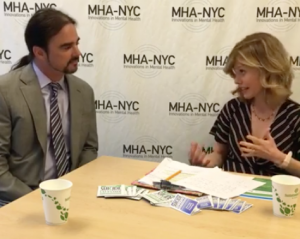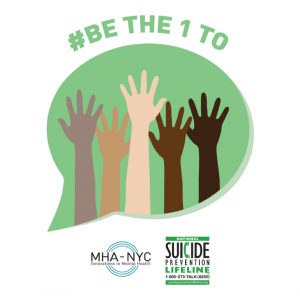#WriteOnSarah: Suicide Prevention and #BeThe1To


Dr. John Draper, Director of the Lifeline, and Sarah Vander Schaaff, mental health writer and advocate
This month, the entire country is focused on suicide prevention. But as the theme “Be The One To” (#BeThe1To) indicates, this is about one person at a time making a difference in someone’s life.
What I love so much about this campaign is that it asks us to relate to one another with open eyes and compassionate hearts. If we can use social media to reinforce that type of interpersonal connection, then we’ll heal a lot of pain and isolation.
And maybe save a life.
It’s also significant that this awareness occurs just as we head into autumn and move into a new season, school year, succession of holidays, and final months of 2016. It’s a time full of heightened expectations and the very real emotional pain that often follows.
The National Suicide Prevention Lifeline, known as Lifeline, is helping us all “be the one to” reach out. Their campaign, part of the larger outreach by the Mental Health Association of New York City, offers five key points.
When I interviewed Project Director, Dr. John Draper, on Tuesday to ask him about the campaign, it was clear to me that he wants to change the conversation about this epidemic.
“There is no life to lose,” he told me. We must talk about the effective ways to prevent suicide and remind people that they have the ability to do a great amount of good. It starts by reaching out to those who may be in need of some support and asking them the very direct and honest question:
“Are you thinking of killing yourself?”
Dr. Draper puts this first step in context in the Facebook Live interview we had on Tuesday, launching an entire month of suicide prevention awareness that I hope extends into the months and years to come.
One of the most moving aspects of this interview for me was something that happened after the interview. I read the comments from people who were watching. They shared their pain, their hard work to make it through another day, and their support for one another.
Here’s a recap of the 5 steps in the #BeThe1To campaign for suicide prevention:
 #BeThe1To: Ask.
#BeThe1To: Ask.
Don’t be afraid to ask the tough question. If someone you know is in emotional pain, ask them directly, “Are you thinking about killing yourself?”
#BeThe1To: Keep Them Safe.
If your friend is thinking about suicide, ask if they’ve also thought about how they would do it. Separate them from anything they are thinking of using to hurt themselves.
#BeThe1To: Be There.
If your friend is thinking about suicide, listen to their reasons for feeling hopeless and in pain. Listen without judgment and with compassion and empathy.
#BeThe1To: Help Them Connect.
Help your friend connect to a support system so they have others to reach out to for help: whether it’s 800-273-TALK (8255), family, friends, clergy, coaches, co-workers or therapists.
#BeThe1To: Follow Up.
Making contact with a friend in the days and weeks after a crisis can make a difference in keeping them alive. Check in with the person you care about on a regular basis.
The Lifeline, launched in 2005 by the U.S Substance Abuse and Mental Health Services Administration (SAMHSA) and the Mental Health Association of New York City, provides free and confidential emotional support to people in suicidal crisis or emotional distress 24 hours a day, 7 days a week.
Additionally, veterans, active military, and their families can be connected to a veteran suicide prevention hotline specialist through the Lifeline number.
As I’ve spoken and exchanged emails with people who face their own mental health challenges, I’ve heard a recurring theme: it’s hard to find help, and even harder to find it when you are suffering. It’s essential that we make the Lifeline for help as readily accessible as possible.
- Share the Lifeline number: 1-800-273- TALK (8255).
- Download and share the #BeThe1To Graphics and Social Media Toolkit here.
- Download and share the MY3 App.
- Learn about Facebook, Twitter, and YouTube features to report or flag suicidal or content. Click here for information on these and other social media safety teams.
Watch the Facebook Live Interview with John and me by clicking here. You’ll learn a lot in the first 5 minutes. And even more by watching the full 30. But most important, always #BeThe1To…Ask, Keep Them Safe, Be There, Help Them Connect, and Follow Up.
Please share this. It’s time to talk about suicide prevention.
Sarah Vander Schaaff is a writer, blogger and a mother of two from New Jersey, who has struggled with Obsessive-compulsive disorder for as long as she can remember. Her courageous column in the Washington Post (“Obsessive –compulsive disorder nearly ruined her life”, January 4th) received international attention for its honesty and openness. This is the first blog in a regular series for Sarah who will write about the mental health challenges we all face in day to day life.
